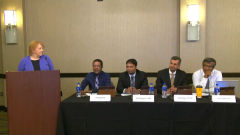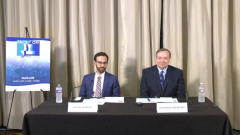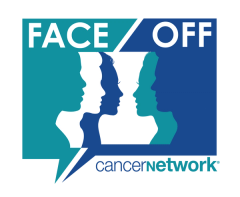
Relapsed/Refractory Multiple Myeloma: The IKEMA Study
Covering the first of two abstracts, Wilson Gonsalves, MD, reviews data from the IKEMA study of isatuximab KD in patients with relapsed/refractory multiple myeloma.
Episodes in this series

Transcript:
Judy Schreiber, PhD, RN: Now, we’re going to move on to Dr Gonsalves, and he’s going to present 2 different abstracts for us, one on the IKEMA trial, and then one looking at biochemical vs clinical progression. Thank you.
Wilson Gonsalves, MD: Sure. Great. Thank you. The first of two abstracts, actually, this is an abstract, and the next presentation will be a manuscript. This abstract is the updated progression-free survival [PFS] and depth of response in the IKEMA trial [NCT03275285]. This was a randomized phase 3 trial of isatuximab, carfilzomib, and dexamethasone [Isa-Kd] vs carfilzomib and dexamethasone in relapse multiple myeloma. This was presented at the 2022 ESMO [European Society for Medical Oncology] meeting. I’m going to take some of the original data in schemas from the paper that was published first in the Lancet in 2021. So, just some background, CD38, it’s been a staple target in multiple myeloma, and it functions as an ecto-enzyme receptor that’s uniformly expressed on myeloma cells. Isatuximab, which is 1 of 2 existing monoclonal antibodies targeting CD38, the other one being daratumumab, works by binding CD38, and works through various different actions, to say the least, but in general, incorporates increasing the amount of cellular cytotoxicity against the myeloma cells, possibly has some direct apoptosis effects too, does a lot of immunomodulation and also some inhibition of ecto-enzyme activity in the NAD+ [nicotinamide adenine dinucleotide] pathway, thus making the marrow microenvironment less immunosuppressive. This regimen has already been approved in various countries based on the original data presented back in 2021. It’s been approved after one or more prior lines of therapy. We’ll just take a quick snapshot of what the schema looks like. [With] relapse multiple myeloma, you needed to have at least one prior line of therapy, you’re risk stratified by one vs more than one line of therapy. Overall, they included only patients with 1 to 3 prior lines of therapy. You could not have had prior carfilzomib, and you should have not been refractory to a prior anti-CD38 antibody.
Now, for the randomization, it was a 3 to 2 randomization in the isatuximab-carfilzomib-dex arm. The isatuximab was dosed how we are used to dosing it weekly for the first cycle, then every other week thereafter. The Kyprolis [carfilzomib] was dosed initially day 1 of cycle 1 at 20 mg/m2 and then moved up to 56 mg/m2, and it followed the twice-weekly dosing of days 1, 2, 8, 9, 15, 16. The dex was given at 20 mg on each of those days of infusion, including days 22 and 23. The control arm was just Kyprolis and dex given the same way as the Isa-Kd arm received it. People were treated until they had either progressive disease [or] unacceptable toxicities, or at removal by the patient’s request. The primary endpoint here is it was an intent-to-treat analysis, and the primary endpoint was progression-free survival as determined by an independent review committee. The key secondary endpoints here are overall response rate, the rates of VGPR [very good partial response] or better response rates, MRD [minimal residual disease] negativity, CR [complete response] rates, and overall survival. This is the concert diagram of just how patients were deemed eligible and then enrolled. Basically, 341 patients were eligible, and out of those, 302 eventually were enrolled, 179 and up on the experimental arm of isatuximab-carfilzomib-dex, and 123 ended up on the control arm of carfilzomib and dex, and those were included in the intent-to-treat analysis. This is going to strain everyone’s eyes to try to read this, but I’m going to summarize this just with key points. We’re overall balanced in terms of both arms, but I want to stress the key things to look at here is the bottom of that second table. What type of population were you dealing with? How many of these patients were refractory to lenalidomide therapy, when I think about the United States population that we treat? Roughly a third of these patients were refractory to lenalidomide on there, and roughly half of these patients enrolling on this study were refractory to their last line of therapy. Here’s the progression survival curve that was originally published in the Lancet showing markedly superior PFS in favor of the isatuximab group. It was in the order of close to 35 to 36 months compared [with] the control arm of Kd being roughly around 19 months with a hazard ratio of 0.531.
Now, here was the overall response rate reported originally. And you can see that the depth of response in terms of complete responses and VGPRs were in favor of the isatuximab group, and you can look at it when they lump it statistically. Overall response rate [is] about the same, but when you look at depth of response, the VGPR or better rate [is] 73% vs 56%, and the MRD negativity rate was 30% vs 13%. So more than double. The CR rate was 40% vs 28%. This group of MRD negative as well as in a CR was roughly 20% vs 11%, and one of the things we all realize with these monoclonal antibodies is that they cause issues when you’re trying to assess responses, especially when VGPR and CR and so on are dependent on the immunofixation, and they can interfere with that assay and the immunofixation can be positive. As such, the goal of this abstract, which was presented at ESMO, was not just longer follow-up, but also using the HYDRASHIFT isatuximab assay to account for that immunofixation. With that, you can see the overall response rates; while they’re the same, you can see the CR rates in the isatuximab-carfilzomib-dex arm are about 4% to 5% higher than what was originally published on the after-counting for this. Same thing for the MRD negative and CR rates, roughly about 26% vs 12%. They also reported on median PFS-2, which is something to think of as we’re testing these therapies in first relapse and second relapse since myeloma is one of those fields where you have so many other lines of therapy just to understand whether you’re changing the natural history of the disease. The median PFS-2 was also superior in terms of the isa-carfilzomib-dex arm. They didn’t have any significantly different safety updates in the abstract that was presented at ESMO rather than a lot of what was expected in terms of the most common any-grade events that you would expect with isatuximab, like infusion reactions, roughly 46% diarrhea, roughly 40% hypertension and upper respiratory tract infections, all higher in the isatuximab arm compared [with] just the carfilzomib and dex arm. In summary, the author’s conclusions that we can go back after, is as to what we think, but there are conclusions where addition of isatuximab to Kd clearly improves progression-free survival and PFS too over the control arm; it improves depth and quality of response, and seems to be a reasonable option in patients with relapsed myeloma with more than one line of therapy, especially with prior exposure or refract-ness to lenalidomide.
Transcript edited for clarity.
Newsletter
Stay up to date on recent advances in the multidisciplinary approach to cancer.




















































































